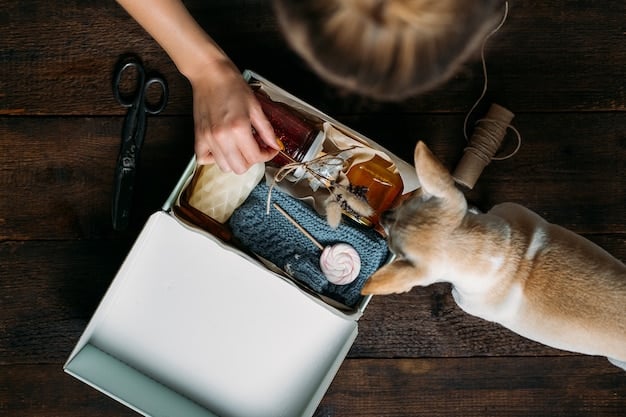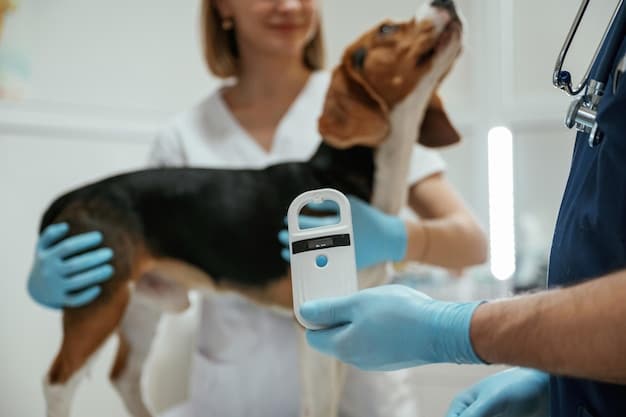Emergency Preparedness for Pets: Your Step-by-Step Disaster Guide

Anúncios
Emergency preparedness for pets is crucial; this guide provides a step-by-step strategy ensuring your furry friend’s safety during disasters, including creating an emergency kit, planning evacuation routes, and understanding specific needs for different types of pets.
Ensuring the safety of your beloved pets during emergencies requires careful planning and preparation. Our comprehensive guide, Emergency Preparedness for Pets: A Step-by-Step Guide to Keeping Your Furry Friend Safe During Disasters, will equip you with the knowledge and tools to protect your animals when disaster strikes.
Anúncios
Why Emergency Preparedness for Pets is Essential
Planning for emergencies is something many pet owners overlook. However, like humans, pets are vulnerable during natural disasters, house fires, or other crises. Without a plan, your pet’s safety and well-being could be severely compromised.
Having an emergency plan for your pets isn’t just about providing food and water; it’s about ensuring they have safe transportation, proper identification, and necessary medical care. It’s also about peace of mind for you, knowing you’ve done everything possible to safeguard your furry family members.
Anúncios
Understanding Local Risks
Before you start assembling your pet emergency plan, consider the specific disasters common in your geographical location. Are you in an area prone to hurricanes? Earthquakes? Wildfires? Understanding these risks helps tailor your preparedness strategy.
For instance, if you live in a flood-prone zone, you may need to invest in waterproof carriers or designate a high ground meeting point. If wildfires are a threat, having pet-friendly air filters or evacuation plans to areas with cleaner air is essential. Being proactive and localized makes your plan more effective.
- Identify Potential Hazards: Research common emergencies in your area.
- Assess Your Home: Determine potential dangers inside your house.
- Consider Your Pet’s Needs: Recognize any specific health concerns or requirements.
Ultimately, knowing and understanding unique risks enables a tailored and effective emergency action plan, keeping your pets safe when moments count most.
Creating a Pet Emergency Kit

At the heart of any solid emergency plan for your pets is a well-stocked emergency kit. Think of it as a survival kit for your animals, containing everything they need to stay safe, healthy, and comfortable during a crisis.
This kit should be easily accessible and portable, so you can grab it quickly when evacuating. Regularly check and replenish items to ensure freshness and usability. Customizing the kit to your pet’s specific needs will make it even more valuable.
Essential Items for Your Pet’s Emergency Kit
While every pet is unique, there are certain essentials that should be in every emergency kit. These items can help address basic needs and minimize stress during uncertain times.
Remember to tailor the kit based on the number and type of pets you have. Consider creating individual kits for each animal, especially if they have distinct dietary or medical requirements.
- Food and Water: A three-day supply of non-perishable food and bottled water.
- Medications: Any necessary prescription medications, along with a copy of their medical records.
- First-Aid Kit: Bandages, antiseptic wipes, and other basics for treating minor injuries.
- Collar with ID Tag: Current identification tag with your pet’s name, contact information, and any relevant medical information.
Creating and maintaining a well-stocked emergency kit ensures your pets have immediate access to essential supplies, buying time and creating a safer environment during crises.
Evacuation Planning for Pets
In an emergency, evacuation may be your only option. Planning ahead to ensure your pets can safely evacuate with you is crucial. Many shelters do not accept pets, so it’s necessary to identify pet-friendly alternatives in advance.
Start by researching pet-friendly hotels, motels, and boarding facilities in your area and along potential evacuation routes. Having a list of contacts readily available can save precious time during a disaster.
Identifying Pet-Friendly Shelters and Hotels
Finding safe lodging for your pets can be challenging when disaster strikes. However, taking the time to identify potential options beforehand drastically improves your chances of a smooth evacuation.
In addition to shelters and hotels, consider friends or family members who live outside the immediate danger zone and are willing to take in your pets temporarily. Networking with local pet organizations can also provide valuable resources and contacts.
- Create a List: Compile a list of pet-friendly accommodations.
- Contact Information: Include addresses and phone numbers for easy access.
- Virtual Meeting Points: Establish gathering points with friends or family.
Careful planning and proactive thinking are the most important components of keeping your pets safe during potential evacuations.
Microchipping and Identification
One of the best ways to ensure your pet’s safe return if they get lost during an emergency is to have them microchipped. A microchip is a small, permanent identification device implanted under your pet’s skin.
Veterinarians and animal shelters can scan the microchip to retrieve your contact information and reunite you with your pet. Keep your contact information up to date with the microchip registry to maximize its effectiveness. A visible ID tag is also essential.
The Importance of Updated Information
Even if your pet is microchipped, the system only works if the information associated with the chip is current. This includes your address, phone number, and any alternate contact details.
Whenever you move or change your phone number, update the microchip registry immediately. Many microchip companies offer online portals where you can easily manage your account and ensure your information is accurate. A consistent effort in keeping your pet’s information up to date will help should they become lost.

Microchips are a life-saving technology, ensuring swift and accurate reunifications between owners and pets, but they’re only as good as the records you maintain.
Practicing Emergency Drills with Your Pets
Familiarizing your pets with the sights, sounds, and procedures involved in an emergency evacuation can reduce their stress and improve their cooperation during a real crisis. Regular practice drills can make a big difference.
Start by gradually introducing your pets to their carriers. Make the carrier a comfortable and safe space by placing their favorite toys or blankets inside. Practice short trips in the carrier to acclimate them to the feeling of being confined.
Steps for Conducting Effective Drills
When conducting emergency drills, simulate real-life scenarios as closely as possible. Use verbal commands and visual cues to guide your pets through the evacuation process. Reward them with treats and praise to create positive associations.
Conduct drills at different times of the day and under varying conditions. This helps your pets become accustomed to responding to emergencies regardless of the environment.
- Acclimation: Get pets comfortable with carriers.
- Verbal Cues: Use clear commands during drills.
- Positive Reinforcement: Reward good behavior with treats and praise.
- Varied Conditions: Practice in different scenarios to increase adaptability.
Emergency drills not only prepare your pets physically but also mentally, making them more resilient and compliant during actual emergencies.
Addressing Specific Needs for Different Pets
Not all pets are created equal, and different species have different needs during emergencies. A plan that works for a dog may not be suitable for a cat, bird, or reptile. Tailoring your emergency preparedness strategy to each pet’s unique requirements is crucial.
Consider factors such as size, mobility, dietary restrictions, and sensitivity to stress. Exotic pets may require specialized enclosures or temperature control. Understanding these specific needs helps ensure every pet’s safety and comfort.
Tailoring Your Plan to Individual Species
Whether you have a goldfish, a hamster, or a parrot, each animal has unique requirements in an emergency. Birds need secure carriers with proper ventilation, reptiles require careful temperature regulation, and small mammals need protection from drafts and sudden movements.
Consult with your veterinarian or a species-specific expert to gain a better understanding of your pet’s individual needs and create an appropriate emergency plan. Preplanning for species-specific differences will provide an added layer of safety.
Emergency Preparedness for Pets | Key Steps |
|—|—|
| 🎒 **Emergency Kit** | Ensure you have food, water, meds, and first aid supplies. |
| 📍 **Evacuation Plan** | Identify pet-friendly accommodations and meeting points. |
| 🆔 **Microchipping** | Your pet has a current microchip & ID tag. |
| 훈련 **Drills** | Practice drills so your pet is familiarized with the crisis process. |
Frequently Asked Questions (FAQ)
▼
It’s crucial to inspect your emergency kit every six months. Review expiration dates on food and medications, replacing items as needed. Update contact information and customize the kit to reflect any of your pet’s changing requirements.
▼
▼
▼
▼
Conclusion
Being prepared for emergencies is a responsibility we owe to our beloved pets. By taking the time to create a comprehensive emergency plan, you can protect your furry friends and provide them with the safety and security they deserve during times of crisis. Remember to stay informed, stay prepared, and stay safe.






